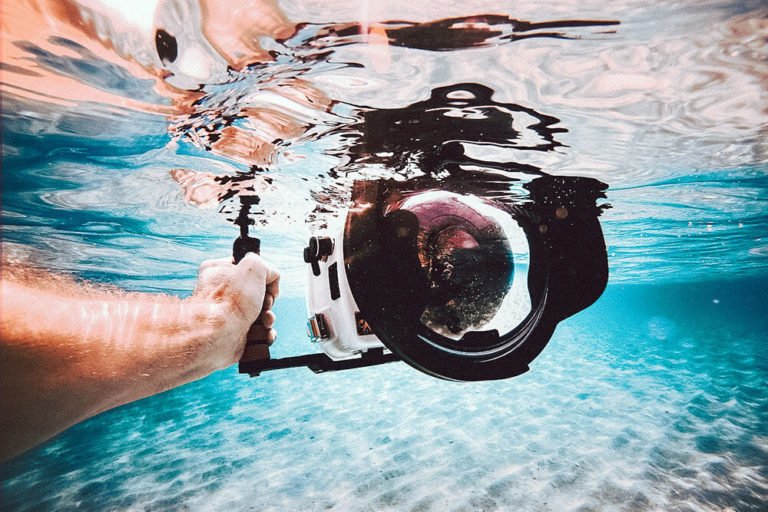How to Become an Underwater Photography Pro

We’re big fans of diving in the moment, but some underwater sights are worth preserving. We’re talking about deep sea photography and how to snap like a pro—whatever your experience level.
Creating stunning pictures isn’t just about buying an expensive camera, though. In fact, it’s not so much about the camera at all. It’s about planning, maneuvering, and accessorizing. Before you start taking commissions or clearing space in your home for a gallery wall of framed expeditions, tune into these tips.
KNOW YOURSELF AND YOUR CAMERA
Scuba diving sans cameras requires plenty of care and attention. Make sure you’re comfortable in the water before letting your camera tag along. Once you’ve decided to dive with an optical instrument, choose waterproof housing (read: pressure-proof camera case) that will protect your camera without hindering the photo quality.
BE PREPARED
Before you dive, choose a subject and plan accordingly. If it’s sharks you’re after, make sure they inhabit an area before you set up shop. Ask locals or other photographers for advice on locations, subjects, and any other topics that might enlighten your session.
SMOOTH YOUR MOVES
Let’s talk about buoyancy and movement. These two are vital to diving and even more so to underwater photography. Bringing a camera down changes your normal scuba pull, so practice steadying yourself for shake-free shooting. Mimic the actual weight of your camera by stuffing your housing with bubble wrap or a cloth. Try in shallow water or even a swimming pool first.
INVEST WISELY
Remember when we said awesome pelagic images aren’t as much about the camera? We weren’t lying. Rather than overspending on a camera, invest in good lenses and lighting (flashguns or strobes), which elicit sharper images and truer colors. This is especially helpful with fast swimming subjects.
GO WIDE (OR MACRO)
There’s more to lenses than meets the eye. Two failsafe options are wide angle and macro. True to their name, wide angle lenses are great for photographing wide shots of subaqueous scenery, whether its schools of technicolor fish or sweeping coral reefs. Macro lenses are all about focus; it requires focus to master usage and provides great detail when capturing creatures closeup.
LEVERAGE LIGHTING
For quality underwater images, use a flash. The deeper you dive, the more color water sponges up (and away from your photos). Retain those warmer hues by befriending a flashgun.
If you’re less than 30 feet under, try using natural light. Shooting when the sun is directly overhead enables the widest sun beam on the water.
SLOW DOWN AND GET CLOSER
The closer you are to your subject, the better. To create impressive pictures, you’ll want to be within touching distance and remain as cool and collected as possible. Get the hang of diving with your camera without alarming sea subjects. Remember, marine life was there first. Be respectful by swimming slowly and parallel to your subject. This way, you’ll avoid scaring creatures and reap better results.
DIVE WITH AN EXPERT
What better way to reach your own photography goals than diving with an expert. Odds are they’ve had their fair share of successes and failures. Learn from them, and take advantage of a second set of hands and eyes.
EDIT AFTER
If you really want to up your photography game, check out some post processing software. This will allow you to edit and improve your photos in case things below the surface didn’t go as swimmingly as you hoped. Adding filters, correcting color, and zapping flaws or unexpected floaties will transform your images from amateur to amazing. Still, the best advice we can give is to focus on time spent in the water over hours at the screen.
SHARK-SPECIFIC TIPS
Cool creature alert. With everyone’s favorite week drawing near, we wanted to share some tips specific to capturing these magnificent marine dwellers in their best light.
CHOOSE YOUR LENS CAREFULLY
Contrary to what you might think, most sharks err on the side of skittish and shy. That means your lens shouldn’t be too wide or too slow (16-35mm or 17-35mm).
DIM THE LIGHTS
Shift your strobe lights to a manual setting, and keep them on low power. Situate them slightly higher than normal to accommodate sharks’ bright underbellies. Don’t overexpose either in case your subject swims closer than expected — when you least expect it.
EXPERIMENT WITH ANGLES
For the most interesting shots, position yourself slightly below the shark. That way, you’ll catch both the underbelly and side of the shark for a more complete view. Still, it’s fun to vary your perspective, so get creative.
DON’T LET DISTANCE DECEIVE
Clear water especially can throw off your depth perception. Take test shots to refine your settings before diving into your shark shoot.
